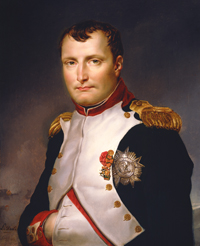University art expert discovers £2m Napoleon painting
Release Date 30 September 2013

A long-lost portrait of Napoleon Bonaparte by renowned 18/19th century French artist Jacques-Louis David has been discovered in New York by a University of Reading researcher.
Previously thought to be a copy, the painting captures Napoleon pledging to defend France in 1813 in its hour of need, as the British and Prussians threatened to invade and occupy France. It was sold to a New York private collector for around £15,000 (pre-auction estimate) in 2005 but extensive work by French art expert Dr Simon Lee has revealed that is a genuine ‘David'.
Although yet to be officially valued the portrait could be worth over £2 million, with the most recent David portrait selling for £2,140,000 in Paris in 2006 and the Battle of Waterloo Bicentenary in 2015 potentially boosting its value.
Jacques-Louis David was the foremost European painter from about 1780 until his death in 1825. He pioneered the austere Neo-Classical style then served the French Revolution, painting such works as 'Marat at his Last Breath'. He then converted to the cause of Napoleon, painting the huge 'Coronation of Napoleon and Josephine', now in the Louvre.
This picture, painted in 1813 and almost certainly in Paris, was first recorded in the collection of the Borthwick-Norton family at Borthwick Castle in southern Scotland. It proceeded by descent to Eva Sardinia Borthwick-Norton which she gifted to the Royal Scottish Academy. After acquiring it through auction, the collector had it cleaned where its obvious quality emerged. On recommendation, the collector contacted Dr Lee from the University's Department of Art to ask for his help in authenticating the portrait.
Dr Lee said: "I am thrilled to have discovered this beautiful painting which offers a unique insight into the role that art could play at a time of war. By having his portrait painted in National Guard uniform, Napoleon was promoting himself as protector and defender of the nation at the time when France was under great threat. David produced an image of the Emperor to galvanise resistance and foster patriotism, yet the painting never reached a wide audience because of the unexpectedly swift allied invasion that ensured the image remained uncirculated and practically unknown.
"How it came to be in Scotland is not known but France and Scotland had an ancient alliance against the common 'enemy' - England. So it's presence in Scotland might be more evidence of an admiration for the Emperor."
Dr Lee used various research methods to authenticate the painting. A contemporary print made after the painting, with a caption identifying David as the painter, was confirmation that the picture existed in its own right and was not a copy of another work. Dr Lee also saw there was a slight difference in uniform styles when comparing known versions of the portrait to the one he was asked to examine. In the newly discovered portrait, Napoleon's white flap of the right cuff has three buttons, set in a triangular formation but in existing versions of the portrait there are only two fastened cuff buttons set in a row.
For further confirmation Dr Lee visited the Frick Collection to compare the portrait with that of David's Portrait of Countess Daru of 1810. Using a special conservator's light he found that both had identical painterly mannerisms and methods of rendering facial features and modelling the drapery.
As well as providing evidence of its authenticity, the cleaned portrait also revealed fascinating clues about a potential tension between David and his assistant.
Dr Lee continued: "Although the painting is signed with David's genuine signature, the cleaning revealed the word Rouget and the date 1813 appeared in the underpaint. Georges Rouget was David's preferred assistant for almost ten years. David called him 'my right arm' and it was often David's studio practice to have Rouget transfer an image to the canvas, sketch in the main lines of the composition and then block in the colours. David would then provide the fine modelling of the head and likeness and the final touches.
"The odd thing is that the word 'Rouget' does not appear as Rouget's usual signature- so why is the word there? I believe its Rouget asserting his part in the process. He knew his name would be covered up and so it was perhaps a minor act of frustration or rebellion. Some collectors or museums might be put off by having two names on the canvas- but in many ways that is proof that it is an authentic product of David's working process."
ENDS
For media enquiries please contact James Barr on 0118 3787115
Notes for editors:
Images - credit Collins Fine Art - www.collins-fineart.com
The University of Reading is ranked among the top 1% of universities in the world (THE World University Rankings 2012).
The University of Reading's Department of Art comprises the former long established departments of Fine Art and History of Art. The Department has shared history with our origins in the Reading School of Art, established in 1860 the founding school of the present University. The Department has a distinctive approach to art through a combination of practice, theory and history. All of the academic staff is actively engaged as artists, historians and curators.
